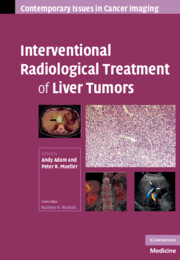Book contents
- Frontmatter
- Contents
- Contributors
- Series foreword
- Preface to Interventional Radiological Treatment of Liver Tumors
- 1 The clinical management of hepatic neoplasms
- 2 Pathology of hepatocellular carcinoma and hepatic metastases
- 3 Diagnostic imaging pre- and post-ablation
- 4 Transarterial chemoembolization in the management of primary and secondary liver tumors
- 5 High-intensity focused ultrasound (HIFU) treatment of liver cancer
- 6 Percutaneous ethanol injection of hepatocellular carcinoma
- 7 The role of surgery in the treatment of hepatocellular carcinoma and hepatic metastases
- 8 Image-guided radiofrequency ablation: techniques and results
- 9 Radiofrequency equipment and scientific basis for radiofrequency ablation
- 10 Cryotherapy of the liver
- 11 Considerations in setting up a radiofrequency ablation service: how we do it
- Index
- Plate section
- References
5 - High-intensity focused ultrasound (HIFU) treatment of liver cancer
Published online by Cambridge University Press: 23 December 2009
- Frontmatter
- Contents
- Contributors
- Series foreword
- Preface to Interventional Radiological Treatment of Liver Tumors
- 1 The clinical management of hepatic neoplasms
- 2 Pathology of hepatocellular carcinoma and hepatic metastases
- 3 Diagnostic imaging pre- and post-ablation
- 4 Transarterial chemoembolization in the management of primary and secondary liver tumors
- 5 High-intensity focused ultrasound (HIFU) treatment of liver cancer
- 6 Percutaneous ethanol injection of hepatocellular carcinoma
- 7 The role of surgery in the treatment of hepatocellular carcinoma and hepatic metastases
- 8 Image-guided radiofrequency ablation: techniques and results
- 9 Radiofrequency equipment and scientific basis for radiofrequency ablation
- 10 Cryotherapy of the liver
- 11 Considerations in setting up a radiofrequency ablation service: how we do it
- Index
- Plate section
- References
Summary
Introduction
In the past, surgery has frequently been the only viable treatment available for solid tumors. Technological advances have, however, led to a shift towards less invasive tumor destruction techniques such as radiotherapy, laparoscopic surgery, and energy-based methods. These include radiofrequency, laser, and cryo-ablation, and HIFU (high-intensity focused ultrasound). There are a number of reasons why non-invasive techniques are appealing: they are usually associated with lower levels of morbidity and mortality, and may often be conducted as day-case procedures under local anesthetic or sedation. In this chapter, the current status of HIFU for the treatment of liver cancer is presented.
Principles of HIFU
Ultrasound is a mechanical form of energy that can propagate through tissue. At the frequencies used in medicine (0.5–20 MHz) the characteristic millimeter wavelengths in tissue mean that it is possible to bring the energy contained in an ultrasound beam to a tight focus a few centimeters from its source. While low-power ultrasound, as used in diagnostic imaging, passes through tissue without causing cellular damage, at high powers the energy concentrated within the focus may be sufficient to lead to cell death, but only within this focal volume, sparing surrounding tissues. This concept is analogous to using a magnifying glass to focus the sun's rays onto tinder with the aim of starting a fire. Combustion is only achieved when the tight focal spot coincides with the dry material.
- Type
- Chapter
- Information
- Interventional Radiological Treatment of Liver Tumors , pp. 92 - 107Publisher: Cambridge University PressPrint publication year: 2008

